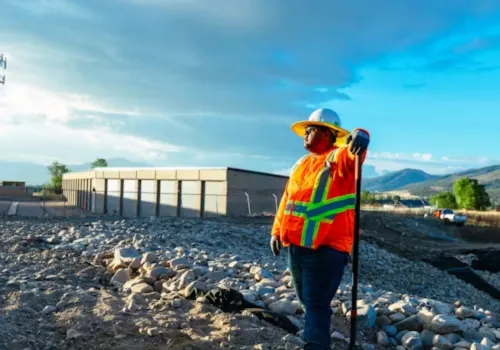
Idaho is turning wheat fields into walls, as builders across the state embrace straw bale construction in what may be the most sustainable building shift in the region’s history.
“We build the most sustainable projects in Idaho,” said Jon Clark, CEO of Earthcraft Construction. “And sometimes we do that with straw bale.”

Clark’s team is part of a movement converting agricultural waste into high-performing buildings that are fire-resistant, well-insulated, and carbon-conscious. Earthcraft’s homes maintain comfortable indoor temperatures year-round — “with no HVAC,” Clark added.
The method involves stacking tightly packed bales of wheat straw — a byproduct of Idaho’s agricultural economy — and plastering them to form exterior walls. Unlike conventional construction that’s riddled with thermal bridges, “the bale wall doesn’t allow [combustion],” Clark explained. “You need heat and oxygen to combust, and the bale wall doesn’t allow that.”
ASTM fire testing confirmed straw bale walls can withstand flame jets for two hours, passing “with flying colors,” Clark said. Add moisture control, superior soundproofing, and seismic performance, and straw bale buildings begin to rival — or outperform — traditional methods.
“It literally takes no added effort, no added energy, to use what is coming out of the field in order to build something,” Clark said. “And not only build something but build something that functions extremely well.”
Local sourcing is at the core of Clark’s model. He partners with nearby farms and mills, sourcing nearly all building materials within 100 miles. The impact: 60% less transportation carbon and support for Idaho’s local economy.
“I’m keeping my money locally with [straw bales],” Clark said. “I’m also keeping my money locally by sourcing my posts and my beams from local mills.”

Meanwhile, the University of Idaho is deepening the momentum. Its $51 million ICCU Arena showcases sustainable mass timber, while the campus energy plant offsets carbon using local biomass. Research into natural fiber composites and lignocellulosic chemistry positions the university at the cutting edge of bio-based construction innovation.
Even the Idaho National Laboratory is involved — helping the bioenergy industry scale technologies that repurpose farm waste into concrete additives, soil binders, and more.
Susan Jacobson of Clearwater County Economic Development calls it part of an emerging biotech boom:
“There’s a lot going on now in the biotech economy... Instead of burning slash piles, now they’re turning it into usable products.”
Companies like Hempitecture are scaling up too, processing tens of thousands of pounds of hemp into thermal insulation. Founder Matthew Mead says:
“Our goal is to produce more sustainable and high-performing bio-based building materials.”
Clark agrees that education is now the biggest barrier, not cost.
“People don’t know about it, and you don’t have builders who are willing to take the risks like me,” he said. “It takes a little bit of education, takes a little bit outside the box thinking.”
He’s addressing that with fiery live demos. At his “Learn and Burn” events, Clark lights wall samples on fire to show the surprising resilience of straw bale assemblies. Officials, architects, and families all leave impressed.
Still, more incentives are needed. Clark calls for tax breaks, streamlined permits, and city-led support. Boise’s Green Building Code and Idaho Power’s energy-efficiency rebates are early steps — but Clark wants more.
“This is not a new thing. It’s been around for well over 150 years,” he said. “There are straw bale houses that are well over 100 years old that are still standing and being occupied and healthy.
Idaho’s straw bale and biomass construction boom is more than just a local trend — it’s a blueprint for future development in agricultural states. With global construction and demolition waste contributing up to 40% of landfill mass, Idaho’s builders are rewriting the narrative.
Clark’s model avoids high-carbon materials like extruded foam and engineered wood. “The difference between what I do [from manufacturers] is that I don’t have to manufacture anything,” Clark said.
This movement is also about resiliency. In wildfire-prone areas of the West, straw bale homes offer fire protection that sticks and bricks can’t match. As insurance companies reprice risk, straw bale could become a safe haven for builders.
From the Treasure Valley to Orofino to the research labs of Moscow, Idaho is proving that sustainability and affordability aren’t mutually exclusive. They're interwoven — like straw in a bale.
Originally reported by Heide Brandes in Idaho Business Review.